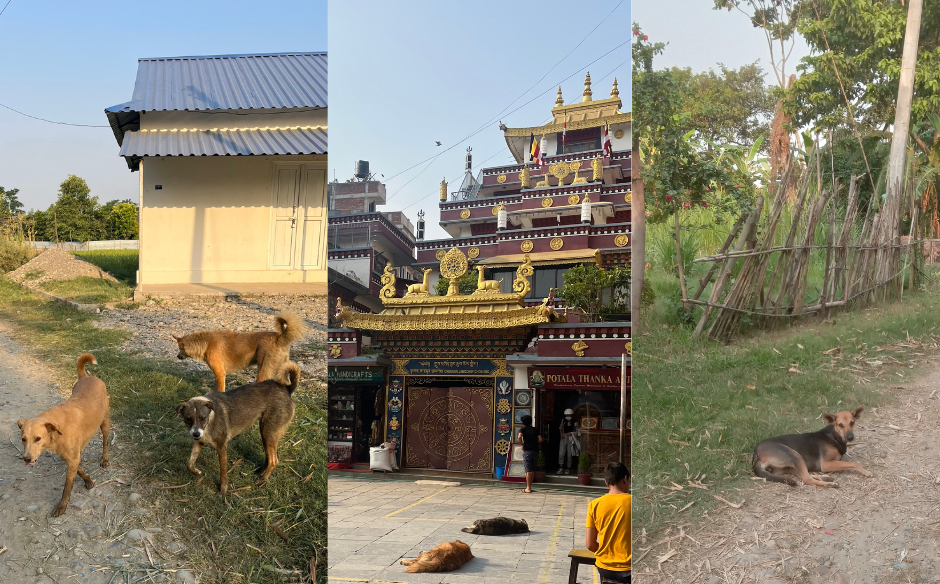One Health in Nepal: Why Dogs Count!
By Laura Bernert, Cornell CALS ’23, Cornell DVM ‘27
It was 5:30 am and I was already sweating when I stepped out of my wooden sleeping hut and into the steamy dawn at Nepal’s Chitwan National Park. It was already 85°F but would reach 105°F before noon. I was up before the sun to complete my summer intern research project — a census of free-roaming domestic dogs in the park’s buffer zone.
I greeted my expert guide and driver, Harka, at the coffee station. He and I were both tired, but we had to beat the heat if we were to count any dogs. During our ride, we drove through rice paddies and mustard fields that characterize Nepal’s lowland Terai region, whizzing past bleating goats and colorful tin-roof houses. From the passenger seat, I directed him using my phone, equipped only with Google Earth and a Census App for record keeping.
As the clock struck 0600, we arrived at our first sampling block—a randomized section of road in which Harka and I would count dogs for today. Our plan was to use counts from ten of these blocks to estimate the number and density of dogs in the area. I let Harka know that we were ready, and on his nod we both took to counting.
This was a different sort of animal watching than most visitors to the national park take part in. Chitwan district is a magnet for ecotourists and is most known for its abundance of wild carnivore and megaherbivore species. From tigers and leopards to elephants and rhinos, Chitwan hosts a wealth of endangered and threatened wildlife. I came to Chitwan, however, with the intention of encountering an entirely different species — Canis familiaris, or the domestic dog.
Unlike my attempts to find more enigmatic species (such as the elusive Bengal tiger!), my efforts to find domestic dogs were quickly rewarded. Dogs were everywhere, roaming freely on the streets and searching for discarded food scraps while cunningly evading oncoming traffic. Harka took care to dodge them as we traversed rural roads, where small packs would occasionally jump out from fields of elephant grass. As we passed through some villages, dogs lay at the feet of people outside their homes, seeking refuge in the shade from the glow of the rapidly rising sun. Although some dogs had attached themselves to particular homes, others roamed more widely and mixed freely with other dogs, people and other animals.
When Harka and I arrived at our first sampling block, an unfamiliar dog came towards us, jumping for food and attention and spotting my clothes with his muddy paw prints! Although I knew better than to yield to the dog’s begging, it became clear to me why these animals are so popular with the local people. It also became clear how they can be pervasive sources of disease. I brushed off the excited dog and chuckled about it with Harka, sharing a mutual appreciation for man’s best friend that was ubiquitous across both of our languages and cultures.
Due to their wide-ranging interactions, free-roaming dogs and their diseases can have a surprising influence on the health of nearby humans and wildlife. For example, my project was inspired by new research that has found evidence that wild tigers and leopards in Nepal have been exposed to canine distemper virus (CDV) that can be lethal in big cats. Dogs are one possible source of CDV transmission to wildlife, and research has found that as many as 80% of local dogs have been exposed to the virus. Furthermore, consumption of dogs by leopards is well documented in the Terai region and provides an opportunity for the big cats to contract the virus.
I personally encountered one such leopard during my brief time in Chitwan, one living at the edge of the village surrounded by an unmanaged dog population in which CDV is common. Seeing this leopard with my own eyes brought to life the purpose of my mission and, together with the friends I’d made in Chitwan, reminded me of why I’d traveled across the globe in the first place. I felt truly inspired to undertake a free-roaming dog census to serve as baseline data for a potential spay/neuter campaign and future vaccination program (against CDV and rabies) in the Chitwan buffer zone. If implemented, such programs have the potential to improve the health of dogs as well as of the people and wildlife all sharing this environment.
Through this project, I gained an appreciation for the concept of One Health in an international context. Over the course of my fieldwork with Harka, the curiosity of local onlookers reminded me that a dog census is quite unusual in the wildlife-centric area of Chitwan. In a town full of jeep safaris and jungle walks, little to no attention is usually paid to the humble dog. Still, my project reminded me of the importance of domestic species as a significant component of a One Health approach to conservation. Given the country’s rich biodiversity, the challenge of managing street dogs in Nepal presents a unique opportunity for collaboration among groups working on wildlife, domestic animal, and human health— as well as those addressing animal welfare. Though a small effort, my census served as a first step towards understanding and eventually managing dog populations in this ecologically sensitive region.
My trip to the far side of the globe brought me to the intersection between wildlife and domestic animal veterinary issues, and this is an area I hope to dive deeper into throughout my time at the Cornell University College of Veterinary Medicine and beyond.
Acknowledgements: This project was made possible with the help and support of Shashank Poudel and the Living with Leopards Project, the Cornell Wildlife Health Center’s Dr. Martin Gilbert, the Himalayan Animal Rescue Trust, and the National Trust for Nature Conservation. Thank you to the Cornell Richard P. Riney Canine Health Center and to Engaged Cornell for their generous contributions that enabled me to complete my census.
Laura Bernert is a first year Cornell University College of Veterinary Medicine DVM student (Class of 2027) from Warrington, Pennsylvania. She completed her undergraduate degree in Animal Science at Cornell University’s College of Agriculture and Life Sciences in 2023. Laura has a particular interest in working dogs and their roles in conservation, something she plans to explore further throughout her veterinary training and career.
All images provided by Laura Bernert.





